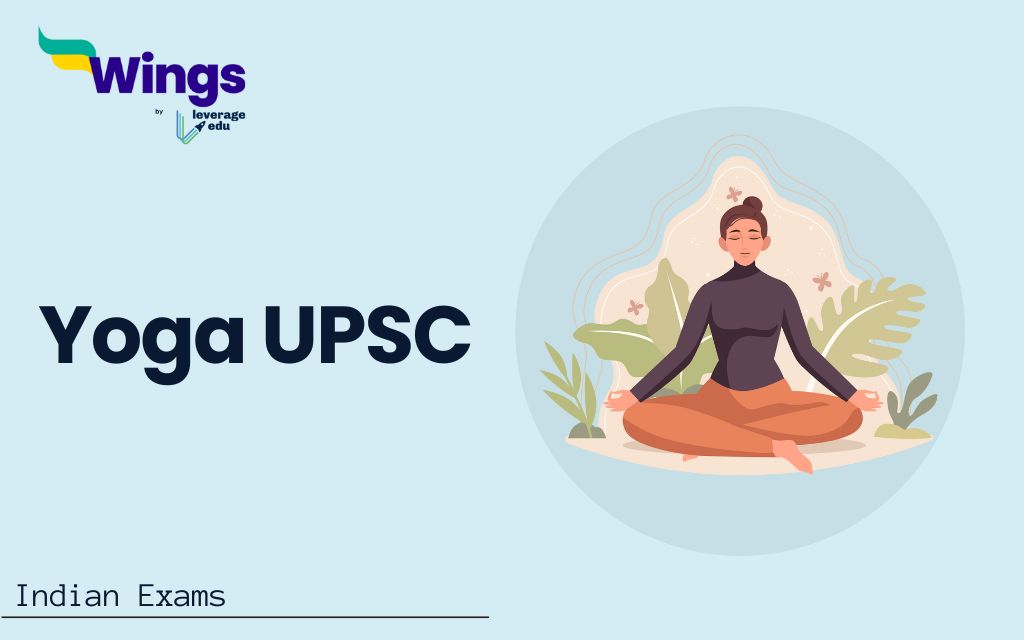Yoga is an ancient Indian practice that combines physical exercises, breathing techniques, and meditation. It’s known for improving strength, flexibility, and mental well-being. Yoga is becoming increasingly popular around the world and even acts as a tool for Indian diplomacy.
Understanding yoga is important for India’s civil service exams, especially under art and culture. This article covers the history, principles, and different aspects of yoga, including famous yoga gurus and important dates like International Day of Yoga. It’s a helpful resource for anyone preparing for these exams.Read this article on Yoga UPSC to learn more about yoga in detail.
Contents
About Yoga
“Yoga” comes from Sanskrit meaning “to join” or “unite.” Goal of yoga is to connect mind and body for harmony.Additional facts related to yoga are stated below:
- Yoga includes physical exercises (asanas), meditation and breathing techniques.
- Benefits of doing yoga typically includes strength, calmness, flexibility, mental peace, overall well-being.
- Different styles use various asanas and meditation techniques.
- 8 popular yoga styles (according to Ministry of Ayush) are:
- Japa Yoga
- Karma Yoga
- Gyana Yoga
- Bhakti Yoga
- Raja Yoga
- Swara Yoga
- Kundalini Yoga
History of Yoga
Yoga is very old, even older than religions.First signs of yoga were found on Indus Valley seals (2700 BC).Here in this section we have written the history of yoga in chronological order:
- Around 1500 BC, the word “yoga” appeared in ancient Indian texts.
- Between 500 BC and 800 AD, yoga became very popular (classical period).
- Patanjali, the “father of yoga”, organized yoga knowledge into “Yoga Sutras”.
- Yoga was used in Buddhism and Jainism for wisdom and peace.
- Between 800 AD and 1700 AD, new yoga forms like Jnana Yoga emerged.
- After 1700 AD, yoga focused more on physical fitness.
- Famous modern yogis include Ramana Maharshi and Vivekananda.
Principles of Yoga
Some important principles of yoga are mentioned in this section:
- Yama (Social ethics): How to behave towards others (non-violence, truthfulness, etc.).
- Niyama (Self-discipline): Healthy habits for the mind and spirit (cleanliness, contentment, etc.).
- Asana (Physical postures): Yoga poses to improve strength and flexibility (warrior pose, lotus pose, etc.).
- Pranayama (Breath control): Breathing exercises to calm the mind and body.
- Pratyahara (Sense withdrawal): Turning your senses inward, away from distractions.
- Dharana (Concentration): Focusing your attention on one thing.
- Dhyana (Meditation): A state of deep, focused concentration.
- Samadhi (Absorption): A state of perfect peace and enlightenment.
List of Yoga Asanas
Here are some common yoga asanas:
- Adho Mukha Svanasana (Downward-facing Dog Pose): This is a widely recognized yoga pose that stretches and strengthens the entire body.
- Padmasana (Lotus Pose): This is a seated meditation pose that improves flexibility and posture.
- Bhadrasana (Butterfly Pose): This pose helps to open up the hips and groin muscles.
- Shirshasana (Headstand): This is an advanced inversion pose that can improve balance and circulation.
- Dhanurasana (Bow Pose): This back-bending pose strengthens the spine and shoulders.
- Dandasana (Staff Pose): This is a basic seated pose that helps to improve posture.
- Virasana (Hero Pose): This kneeling pose can help to improve circulation and digestion.
- Padottanasana (Standing Forward Bend): This forward bend stretches the hamstrings and spine.
- Shavasana (Corpse Pose): This relaxation pose is used at the end of a yoga session to integrate the benefits of the practice.
Importance Of Yoga
June 21st is International Day of Yoga, observed annually to raise awareness about the benefits of yoga.It was declared by the UNGA in 2022.Indian diaspora are considered ambassadors of yoga.In 2022, the theme was “Yoga for humanity”.Here in this section we have stated the benefits of yoga :
- Physical Fitness: Yoga exercises (asanas) can improve your physical health and overall well-being.
- Stress Relief: Yoga helps manage stress and improve mental health by calming your nervous system.
- Spiritual Growth: Regular yoga practice can lead to a deeper understanding of yourself and potentially spiritual growth.
- Career Opportunities: Yoga is becoming a popular career choice with opportunities for teaching and other yoga professions.
- Soft Power for India: Yoga’s global popularity promotes India’s cultural influence (soft power).
- Medical Tourism: People travel to India for affordable yoga-based treatments, boosting the AYUSH medical system.
- Traditional Medicine Revival: Increased interest in yoga helps revive other traditional Indian medicine practices.
Famous Yoga Gurus in India
Here in this section we have stated the name of famous yoga gurus in India:
- B.K.S. Iyengar: Founder of Iyengar Yoga, known for his book “Light on Yoga” and belief that yoga is for everyone.
- T. Krishnamacharya: Yoga and Vedic tradition expert, known for creating the concept of Vinyasa (movement synchronized with breath).
- Baba Ramdev: Popularized yoga in India through TV and large yoga camps. Teaches yoga in the Pranayama style.
- B.K. Asha: Author of yoga and mental wellness courses on stress management, meditation, and more.
- Dr. H.R. Nagendra: President of a yoga institute and Chancellor of a yoga university, recognized worldwide as a yoga guru.
Relevant Blogs
| Ellora Caves | History of Indian Art |
| 5 Most Famous Types Of Paintings in India | Traditional Art Forms of India |
| All the Names of India Throughout History | Tribes of India |
FAQs
Yoga aims to achieve harmony between the body, mind, and spirit through various physical postures.
Eight limbs are: yamas (abstinences), niyama (observances), asana (posture), pranayama (breathing), pratyahara (withdrawal), dharana (concentration), dhyana (meditation) and samadhi (absorption).
Yoga school, founded by the Sage Patanjali, is one of the orthodox schools in Indian philosophy
This was all about the “Yoga UPSC”. For more such informative blogs, check out our UPSCExams Section and Study Material Section, or you can learn more about us by visiting our Indian exams page.
 One app for all your study abroad needs
One app for all your study abroad needs














